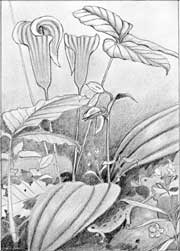 |

by by Gary Pendleton |
 Seize the Day of Spring Ephemera
Seize the Day of Spring Ephemera
They must go down past things coming up
They must go down into the dark decayed.
—Robert Frost: “Hardwood Groves”
Ah, dirt, soil, decay, mold, worms and bacteria. What would life be like without them? Earth Journal begins this week in the zone of life that exists from ankle height down into the rich, lively and essential place called topsoil.
We’ll begin with fallen leaves that, says Frost, “fit the earth like a leather glove.” Just below that tan-colored sheet, patterned with the forms of oak, hickory, beech, et al., the soil is dark and crumbly. Comprised of generations of fallen leaves, it is almost all organic matter. With very little clay or sand, it holds onto moisture, and it is rich in nutrients. There is lots of life in the soil, and it is life-giving. It can take years to build a few inches of topsoil, on which we depend for food and forest products as we also depend on air and water.
In the Smoky Mountains of the southern Appalachians are places called hardwood coves. There, hardwood trees grow to monumental proportions, and the forest floor is lush with a great variety of wildflowers. In them, the shape of the land allows the soil to build up deeply, creating the conditions that allow the trees to grow so large and the flowers to proliferate.
But you need not make the long drive to the Great Smoky Mountains to pay homage to the soil that is “pierced by flowers and put beneath the feet of dancing flowers.”
Closer to home there are wooded places, where, in early spring, orchids, lilies and an impressive variety of exquisite native plants emerge. The wildflowers that display for a few brief weeks before the trees leaf out are collectively called spring ephemera.
The recent cool weather might delay their blooming. If the weather stays cool, the period of blooming will last longer. A warm spell could hasten the process, causing the flowers to quickly bloom and fade away. After the blooms fade comes a long period called senescence as the above-ground parts break down, leaving hardly a trace.
A good resource for your explorations is the book Finding Wildflowers in the Washington-Baltimore Area by Fleming, Lobstien and Tufty.
The Maryland Native Plant Society will be hosting a series of wildflower walks this spring around central and southern Maryland as well as the Eastern Shore. Find the schedule at www.mdflora.org. Battle Creek Nature Center sponsors an adults-only trip to Flag Ponds to seek wildflowers and mushrooms from 11am-2pm on May 8: 410-535-5327 to register.
